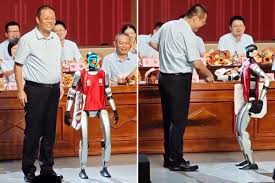
Consider this scenario: you’ve been invited to a family member’s or friend’s graduation ceremony, and as the graduates enter in their caps and gowns, you notice something that attracts your attention. A humanoid robot strides confidently across the stage to accept its certificate.
It sounds like something out of a science fiction or fantasy novel, doesn’t it? It isn’t. On July 1, at the 25th Shuangshi High School graduation in Fujian, a robot named Shuang Shuang (meaning “Bright”) marched to the stage holding an empty tote bag.
Shuang Shuang took up position in front of the podium, where members of the school staff sat. One of the teachers stepped up, approached the robot, shook hands with Shuang Shuang, and inserted a little certificate into the robot’s tote bag, eliciting shouts and admiration from the audience.
The moment the robot received its certification enthralled viewers everywhere and is a potent representation of China’s growing interest in robotics and its aspirational drive towards an AI-powered future.
While Shuang Shuang’s academic career remains a mystery, its existence unmistakably demonstrates the rising integration of robotics into everyday life and, more importantly, the minds of the next generation.
From Classroom Curiosity to Viral Icon: The Rise of Public Robotics
Not much is known about the manufacturer and model of Shuang Shuang, but the robot stole the spotlight on July 1, with videos of the graduation that went viral on Chinese platforms like Weibo and Douyin and on Western outlets like YouTube.
The graduation of Shuang Shuang isn’t an isolated incident; it is the setting stage for the integration of humanoid and animal-like robots into human societies, and China is at the forefront of this revolution.
The appearance of public robotics has been on the rise this year, especially in China. We have the:
- Humanoid robot football match, which was held in June 2025, by Beijing Yizhuang Technology Zone.
- Beijing Human-Robot Half Marathon, which was held in April 2025, with human runners running alongside humanoid robots.
- The Spring Festival Gala, held in February 2025, where Unitree Robotics made a significant splash by having 16 humanoid robots perform alongside human dancers in a folk dance held by China Media Group.
- • The Zhongguancum Forum, held in March 2025, a major tech forum in Beijing, featured nearly 100 humanoid robots offering various services, such as greeting guests, conversing, and stage performance, showcasing their advanced perception and interaction technologies.
China is taking the lead on incorporating robots into the society beyond their use in industrial settings. The Chinese government is undertaking initiatives like “Made in China 2025” to accelerate domestic production, innovation, and adoption of robotics across various sectors like healthcare, logistics, and environmental protection.
Nurturing the Next Generation of Innovators: Robotics in Education
The presence and integration of a robot like Shuang Shuang at a high school graduation is not purely for show. It demonstrates the Chinese government’s dedication to including robotics education in the early stages of education.
China’s education system is actively integrating AI and robotics into its curriculum. Introduction to artificial intelligence and the making of simple robots was introduced as early as 2003 in the new curriculum for senior high school.
Over the years, the commitment has grown more pronounced. For example, in areas like Beijing, kids aged 6 to 18 are required to receive AI instruction beginning in September 2025. The seminar will include discussions about AI ethics, chatbots, and real-world uses of AI.
Early exposure to robotics and AI will not only foster interest in the younger generation for the field but also foster innovations in ways that will leave the world in awe and solidify China’s foothold in dominating global innovation.

